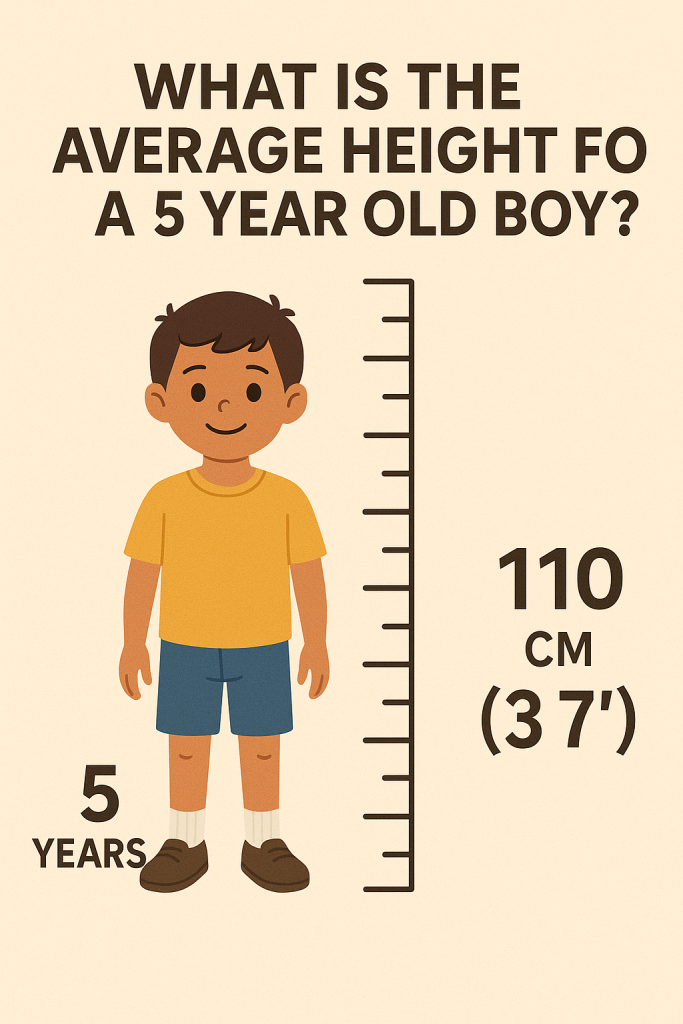Average height for 5 year old boy sparks curiosity about growth and health. How do regions differ? Why are some boys taller? What does this mean for society? This exploration dives into the data, revealing a story of development and opportunity. In 2020, American 5-year-old boys averaged 109 cm (42.9 inches), per CDC data. In England, 2023–2024 data shows boys at 110.3 cm.

In the Philippines, stunting suggests heights around 105–108 cm. For professionals, this data shapes healthcare, education, and product design. Height signals nutrition, care, and potential.
Global Height Trends for 5-Year-Old Boys
Height for 5-year-old boys varies across the globe. In the US, boys average 109 cm, ranging from 100 to 117 cm, per CDC and WHO data. England reports 110.3 cm for 2023–2024, slightly up from 2018–2019. Dutch boys reach ~111 cm, reflecting strong nutrition. In the Philippines, no specific 5-year-old data exists, but 30% stunting suggests boys average 105–108 cm, below global norms. Indian boys hover around 107 cm, per WHO estimates.
These numbers mark early childhood growth. Boys grow 2–3 inches annually from ages 5 to 8. Nutrition drives differences—wealthier nations with protein-rich diets produce taller children. In the Philippines, rice-heavy diets limit growth. Urban boys in Manila may hit 108 cm, while rural peers lag at 105 cm. Professionals can use these trends to design nutrition programs or monitor pediatric health.
Historical Trends in Height
Heights have climbed over time. In the US, 5-year-old boys gained ~2 cm from 1960 to 2020, reaching 109 cm. England saw slight increases until 2019–2020, with a spike in 2020–2021 (110.5 cm) tied to obesity during the pandemic, then a dip to 110.3 cm by 2023–2024. Globally, children are 1–5% taller than 50 years ago, thanks to better diets. In the Philippines, men gained 3.3 cm from 1896 (159.9 cm) to 1996 (163.2 cm), but stunting slows progress for young boys.
The 1980s brought gains in many regions. Improved food access lifted heights. In the Philippines, economic challenges persisted—30% of children face stunting today. Historical data suggests 5-year-old boys in 1990 averaged ~106 cm, inching to 107–108 cm by 2013. No 2025 data confirms this, but trends point to slow growth. Professionals can track health surveys to push for reforms boosting the average height for 5 year old boy.
Influencing Factors
Nutrition shapes height. Protein, calcium, and vitamin D fuel growth. In the US, boys consume ~50 grams of protein daily, supporting 109 cm averages. In the Philippines, rice-based diets lack protein—30% of children are stunted. Urban Filipino boys eating meat and dairy may reach 108 cm, rural boys 105 cm. School feeding programs with milk or eggs can close gaps.
Genetics set limits. Height is ~80% heritable—tall parents often have tall children. But environment outweighs genes. In wealthier nations, better diets lift heights beyond genetic potential. In the Philippines, poverty limits food access, capping growth. Healthcare is critical. Urban clinics provide prenatal care, reducing stunting. Rural areas lack facilities, hindering height for 5-year-old boys. Socioeconomics matter—higher-income families produce taller children by 2–3 cm. Obesity also plays a role. In England, obese 5-year-old boys average 113.2 cm, taller than healthy peers (110.3 cm), but face later growth slowdowns.
Puberty is distant at 5, but early nutrition sets the stage. Poor diets now can delay puberty, limiting adult height. Professionals can advocate for nutrition programs or rural health investments to raise the average height for 5 year old boy.
Regional and Socioeconomic Variations
Height reflects place and resources. In the US, urban 5-year-old boys average 109.5 cm, rural boys 108.5 cm. In England, Greenwich boys reach 111.4 cm, while Herefordshire boys hit 109.4 cm. In the Philippines, urban Manila boys may average 108 cm, rural Mindanao boys 105 cm—a 3 cm gap. Higher-income Filipino boys reach 109 cm, low-income boys 106 cm.
Global differences are stark. Dutch boys at 111 cm outpace Filipino boys at ~107 cm, tied to nutrition and healthcare. These gaps guide action. Urban schools need furniture for taller children. Rural Philippines needs nutrition programs to lift the average height for 5-year-old boys. Businesses can tailor products—urban stores stock larger sizes, rural ones smaller.
Business and Societal Implications
Height for 5-year-old boys informs industries. Pediatricians use growth charts to spot stunting—rural Philippines needs more clinics. Schools adapt to taller children, requiring larger desks or sports gear. In the US, kindergartens design for 109 cm averages. In the Philippines, rural schools plan for 105–107 cm. Apparel brands adjust sizing—Manila stores stock taller cuts, Mindanao ones smaller. Nutrition companies can target stunting-prone areas with protein supplements.
Height shapes culture too. Taller children often excel in sports, boosting confidence! In the Philippines, basketball dreams thrive despite shorter statures. Professionals can design health campaigns or ergonomic products to support growth, lifting the average height for 5 year old boy.
Average Height for 5 Year Old Boy: Actionable Insights
Average height for 5 year old boy reveals health and opportunity. Globally, boys range from 105–111 cm, with US boys at 109 cm and Filipino boys at ~107 cm. Professionals can act—pediatricians can push anti-stunting programs, educators can optimize school meals, and businesses can tailor products. Height data guides smarter decisions. Keep watching—children are growing!
Average Height for 2 Year Old: Growth Insights
Average Height of a Desk: Ergonomic Insights
Average Height of a 4 Year-Old in Feet: Growth Insights
